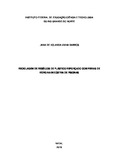Reciclagem de resíduos de plástico reforçado com fibras de vidro na indústria de piscinas
Resumo
Recycling of composite materials has been a challenge today considering the choice
of the type of recycling employed for this material category, since due to the matrix
composition and reinforcement there is a need for the use of specific technologies.
In this context is the recycling of glass fiber reinforced plastic composite (GFRP), a
material found in various market sectors, including automotive and construction, for
example. The GFRP composite has in its composition a matrix (thermoset resin)
and a reinforcement material (glass fibers). A problem currently facing concerns the
generation of waste after the manufacturing process of the GFRP, thus generating
an environmental aspect of waste disposal in industrial landfills or even untreated
disposal. The objective of the present work is to recycle the glass fiber reinforced
plastic waste by grinding and incorporating the particles into a polymeric matrix, in
order to produce a plastic mass for application on the edges of swimming pools in
an industry. For the production of plastic mass (new composite), the matrix /
reinforcement ratio (MR) was considered 20%, 30% and 40%. Specimens (CP)
were manufactured to evaluate the physical properties of density and humidity and
the mechanical flexural property according to the specifications found in American
Society for Testing and Materials (ASTM) D792, D5229 and D790, respectively.
These tests allowed us to identify the viability of the alternative to use the waste in
GFRP within the company's production process. The results showed that the
incorporation of residues in the matrix did not increase the material density in
relation to pure resin. The MR 20% composite presented the lowest density and
moisture absorption capacity, but lower flexural stress among the composites
containing residues. The composites MR 20 and 30 presented the same density
values but the 40 composites were slightly higher, however, considering the
standard deviations the densities were the same; With regard to moisture absorption
the MR 30 had a higher absorption percentage and with respect to the flexural
mechanical behavior, the MR 40 had a higher flexural strength and stiffness.




